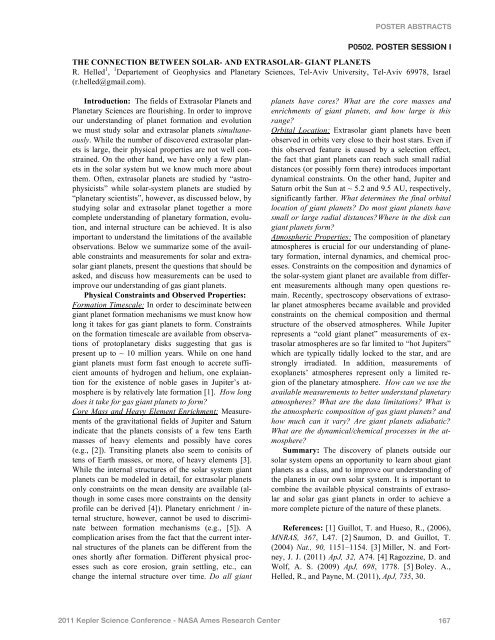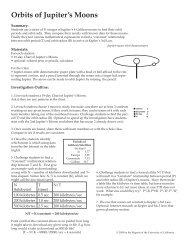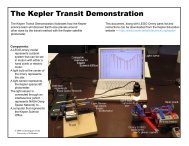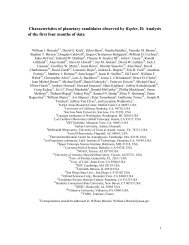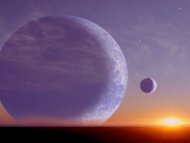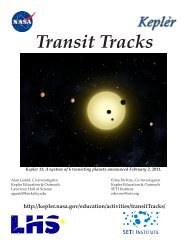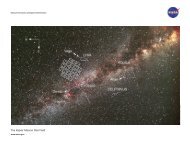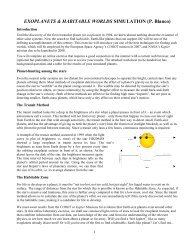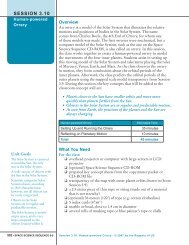Poster Abstracts - Kepler - NASA
Poster Abstracts - Kepler - NASA
Poster Abstracts - Kepler - NASA
- No tags were found...
You also want an ePaper? Increase the reach of your titles
YUMPU automatically turns print PDFs into web optimized ePapers that Google loves.
POSTER ABSTRACTSP0502. POSTER SESSION ITHE CONNECTION BETWEEN SOLAR- AND EXTRASOLAR- GIANT PLANETSR. Helled 1 , 1 Departement of Geophysics and Planetary Sciences, Tel-Aviv University, Tel-Aviv 69978, Israel(r.helled@gmail.com).Introduction: The fields of Extrasolar Planets andPlanetary Sciences are flourishing. In order to improveour understanding of planet formation and evolutionwe must study solar and extrasolar planets simultaneously.While the number of discovered extrasolar planetsis large, their physical properties are not well constrained.On the other hand, we have only a few planetsin the solar system but we know much more aboutthem. Often, extrasolar planets are studied by “astrophysicists”while solar-system planets are studied by“planetary scientists”, however, as discussed below, bystudying solar and extrasolar planet together a morecomplete understanding of planetary formation, evolution,and internal structure can be achieved. It is alsoimportant to understand the limitations of the availableobservations. Below we summarize some of the availableconstraints and measurements for solar and extrasolargiant planets, present the questions that should beasked, and discuss how measurements can be used toimprove our understanding of gas giant planets.Physical Constraints and Observed Properties:Formation Timescale: In order to desciminate betweengiant planet formation mechanisms we must know howlong it takes for gas giant planets to form. Constraintson the formation timescale are available from observationsof protoplanetary disks suggesting that gas ispresent up to ~ 10 million years. While on one handgiant planets must form fast enough to accrete sufficientamounts of hydrogen and helium, one explaiantionfor the existence of noble gases in Jupiter’s atmosphereis by relatively late formation [1]. How longdoes it take for gas giant planets to form?Core Mass and Heavy Element Enrichment: Measurementsof the gravitational fields of Jupiter and Saturnindicate that the planets consists of a few tens Earthmasses of heavy elements and possibly have cores(e.g., [2]). Transiting planets also seem to conisits oftens of Earth masses, or more, of heavy elements [3].While the internal structures of the solar system giantplanets can be modeled in detail, for extrasolar planetsonly constraints on the mean density are available (althoughin some cases more constraints on the densityprofile can be derived [4]). Planetary enrichment / internalstructure, however, cannot be used to discriminatebetween formation mechanisms (e.g., [5]). Acomplication arises from the fact that the current internalstructures of the planets can be different from theones shortly after formation. Different physical processessuch as core erosion, grain settling, etc., canchange the internal structure over time. Do all giantplanets have cores? What are the core masses andenrichments of giant planets, and how large is thisrange?Orbital Location: Extrasolar giant planets have beenobserved in orbits very close to their host stars. Even ifthis observed feature is caused by a selection effect,the fact that giant planets can reach such small radialdistances (or possibly form there) introduces importantdynamical constraints. On the other hand, Jupiter andSaturn orbit the Sun at ~ 5.2 and 9.5 AU, respectively,significantly farther. What determines the final orbitallocation of giant planets? Do most giant planets havesmall or large radial distances?Where in the disk cangiant planets form?Atmospheric Properties: The composition of planetaryatmospheres is crucial for our understanding of planetaryformation, internal dynamics, and chemical processes.Constraints on the composition and dynamics ofthe solar-system giant planet are available from differentmeasurements although many open questions remain.Recently, spectroscopy observations of extrasolarplanet atmospheres became available and providedconstraints on the chemical composition and thermalstructure of the observed atmospheres. While Jupiterrepresents a “cold giant planet” measurements of extrasolaratmospheres are so far limited to “hot Jupiters”which are typically tidally locked to the star, and arestrongly irradiated. In addition, measurements ofexoplanets’ atmospheres represent only a limited regionof the planetary atmosphere. How can we use theavailable measurements to better understand planetaryatmospheres? What are the data limitations? What isthe atmospheric composition of gas giant planets? andhow much can it vary? Are giant planets adiabatic?What are the dynamical/chemical processes in the atmosphere?Summary: The discovery of planets outside oursolar system opens an opportunity to learn about giantplanets as a class, and to improve our understanding ofthe planets in our own solar system. It is important tocombine the available physical constraints of extrasolarand solar gas giant planets in order to achieve amore complete picture of the nature of these planets.References: [1] Guillot, T. and Hueso, R., (2006),MNRAS, 367, L47. [2] Saumon, D. and Guillot, T.(2004) Nat., 90, 1151–1154. [3] Miller, N. and Fortney,J. J. (2011) ApJ, 32, A74. [4] Ragozzine, D. andWolf, A. S. (2009) ApJ, 698, 1778. [5] Boley. A.,Helled, R., and Payne, M. (2011), ApJ, 735, 30.2011 <strong>Kepler</strong> Science Conference - <strong>NASA</strong> Ames Research Center 167


